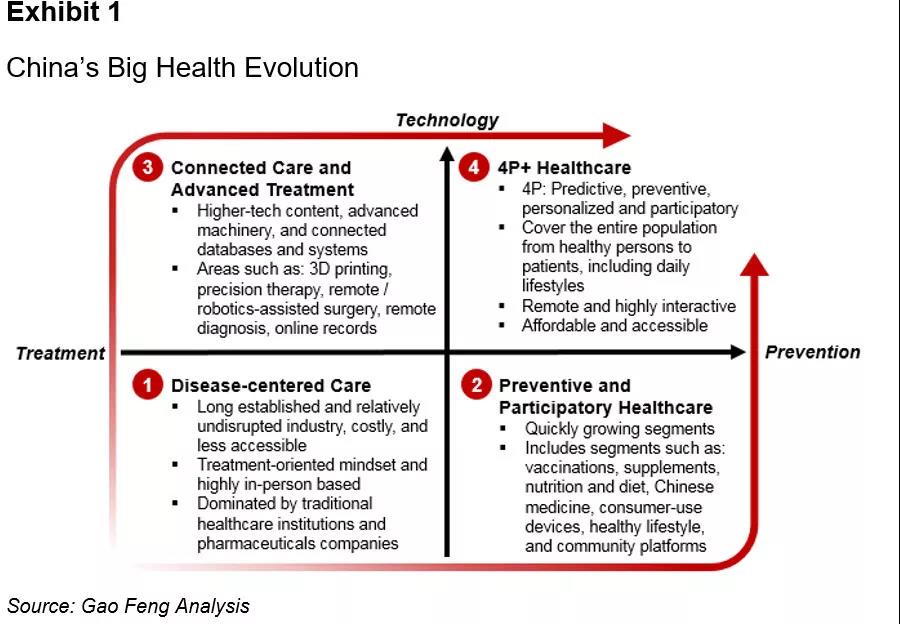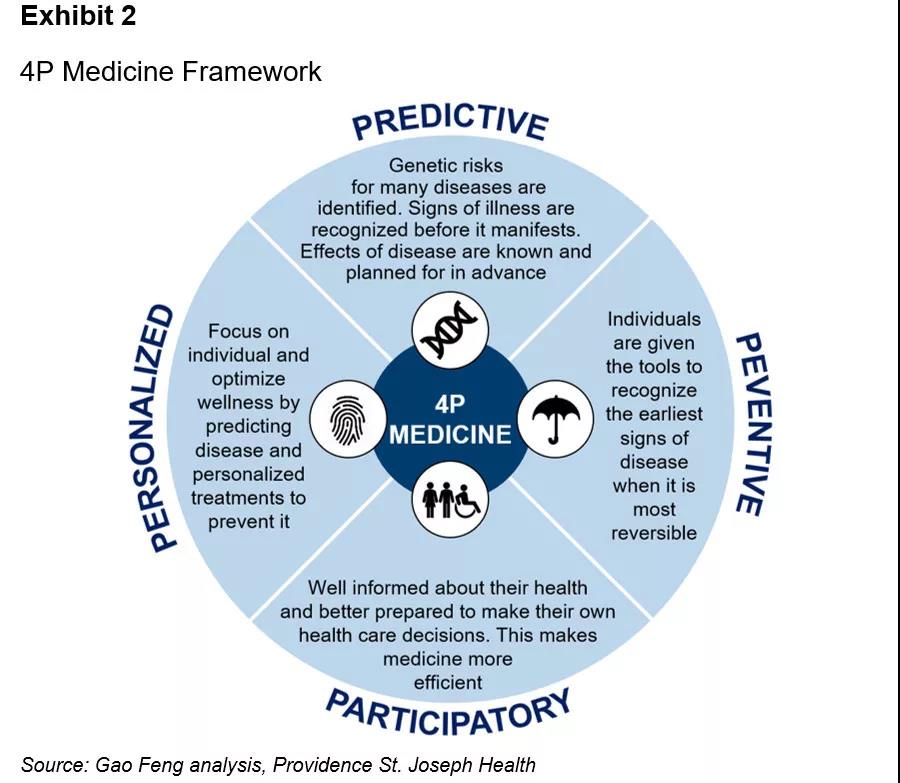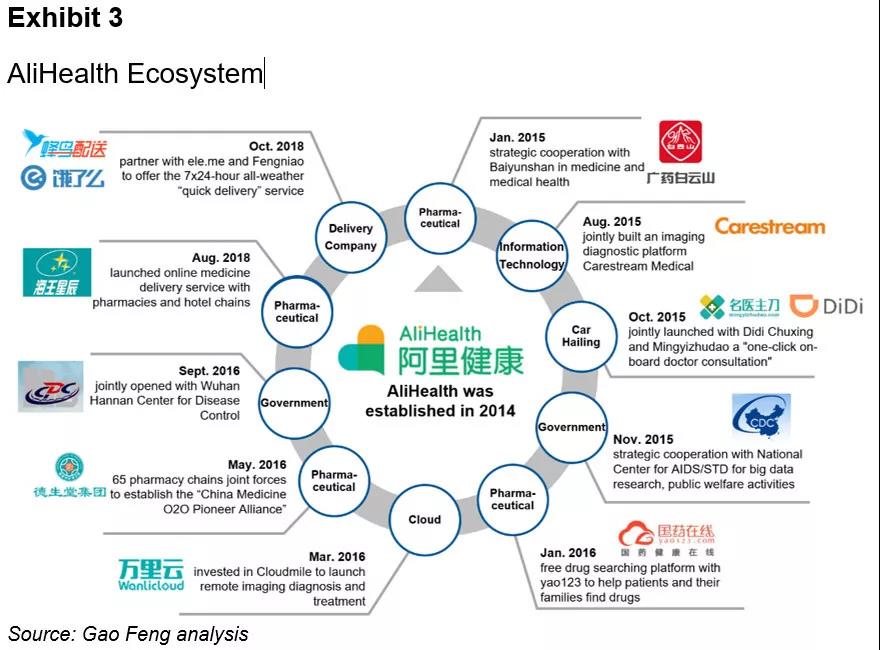 By Andrew Lee
By Andrew Lee
September 2019
Introduction
Improving healthcare is a key strategic initiative of the Chinese government, which places major emphasis on “Big Health”. “Big Health” in the China context embraces all direct and adjacent sectors in order to provide a comprehensive range of products and services that cover healthcare over the entire lives of citizens, in sickness or in health. During the Communist Party of China Central Committee Meeting in 2016, President Xi Jinping announced outline of the “Healthy China 2030” plan. The strategy envisaged in the plan emphasizes the concept of “treatment without disease”, which can lead to stronger demand for preventive medical services. The goal is that improved healthcare should become more accessible to and affordable for China’s 1.4 billion people.
In the last decade, China’s healthcare expenditure grew at around 15% per annum and this momentum is expected to continue at a double-digit pace until 2030. China’s healthcare expenditure as a percentage of GDP still has plenty of room for growth since it is still low compared to more mature countries. For example, healthcare expenditure in China is expected to reach 6.5 to 7% of its GDP by 2020, whereas countries such as the U.S., Germany and the U.K. are at 10 to 18% today. This growth is driven by increase in demand due to growth in proportion of the elderly in the overall population, increasing urbanization and rising middle class. Diversified healthcare players and China’s strategic national mandate are accelerating this growth at the same time.
While China’s healthcare market outlook is promising, its system also has some significant unmet needs and challenges to overcome. For example, one major pain point is the difficulty in accessing medical services. In a patient survey released by China Health Promotion Foundation, the top three issues were long waiting time, insufficient information on where to obtain appropriate services and lack of comprehensive treatment facilities. Additionally, medical services are relatively expensive for most families due to overall resources shortage. The underdeveloped medical insurance system is another reason for expensive healthcare. Other problems include inconsistent treatment service quality, including inefficient and complicated treatment process.
These shortcomings are mostly driven by healthcare institutions’ lack of resources, growing suboptimal health status (SHS), high rate of death because of chronic diseases, as well as China’s aging population driving up the demand for medical services for geriatric syndromes. These challenges are progressively being overcome by industry players as demand for quality healthcare is growing and the market is responding to this demand.
China’s Big Health Evolution
Historically, the healthcare industry has been heavily dominated by traditional healthcare institutions and pharmaceuticals companies, with a mindset that is generally focused on treatment-centered care. In spite of this, China’s Big Health initiative is quickly driving the industry to grow and evolve on two paths and converge towards a “4P+ Healthcare” (Exhibit 1).
The “4P” in 4P+ stands for “Predictive, Preventive, Personalized and Participatory”, while the “+” is ensuring healthcare will cover the entire population from healthy persons to patients, and shall become more affordable and accessible.
In the horizontal path, the industry is moving towards a quickly growing segment of preventive and participatory healthcare. The preventive aspect emphasizes early screening to prevent the potential need for treatment. It aims to recognize earliest signs of a disease when it is most reversible, which in turn would reduce costs of medical treatment, hence placing less burden on the economy.
Typically, preventive treatment is administered through vaccines, Chinese medicines, supplements and preventive medications. However, beyond treatment, this includes monitoring an individual’s daily life with medical devices such as diagnosis meters and wearables. Furthermore, it involves lifestyle changes including one’s daily habits, such as regular exercise, appropriate diet and adequate sleep.
The concept of participatory healthcare means encouraging patients to become more active about their own health. Patients are better informed and encouraged to participate in every step of their healthcare process from community participation, patient education, increasing health awareness and making their own lifestyle choices.
Preventive and participatory healthcare collectively improve the healthcare experience and outcomes, increase satisfaction, reduce medical errors and lower overall healthcare costs. The preventive and participatory market landscape in China is driven by the population becoming more health conscious and willing to devote time, energy and money to their own health.
Meanwhile, industry players are creating healthcare ecosystems with innovative business models to better fit consumer needs. They are introducing health management apps that allow consumers to participate in the process of healthcare by undertaking active health monitoring, ensuring nutrition and diet planning and physical and mental health wellbeing.
The government is extensively supporting the move towards disease prevention, education and adoption of the latest related technologies. The “Health China 2030” blueprint has put forward several measures. Medical insurance and social aid policies are being improved to reduce medical and healthcare costs. Diversified health insurance services will be further developed, with production and supply of medicines to be guaranteed. The government has also extended free vaccination to include adults and not only children. In order to promote national health education, the use of publicity media, such as newspapers, television, radio, the Internet and other forms of new media is being expanded and encouraged.
In the vertical path it is moving towards connected care and advanced treatment which involves the application and development of higher-tech content, advanced machinery and data and systems connectivity. Innovative technologies such as Artificial Intelligence (AI), Big Data, Cloud Services, 3D Printing, Internet of Things (IoT), Virtual Reality (VR) and Augmented Reality (AR) are reshaping China’s healthcare landscape.
New business models are being built upon these technologies, to allow more effective and efficient treatment of patients. Some of these are intelligent consultation through mobile medical platform services which improves communication with professionals, user experience and diagnosis results. Other business models involve use of big data, such as information platform services which collaborate with hospitals to create service-for-data business models. And intelligent medical record analysis services are being provided for helping research and development, and medical risk assessment for other companies.
The two aspects of Predictive and Personalized Healthcare complete the path towards “4P Medicine” (Exhibit 2). Predictive healthcare involves use of technology and big data to increase the effectiveness of preventive care, by identifying signs of illness before it manifests. Advances in prediction techniques have resulted in application of AI for gene sequencing and detection. Numerous companies in China offer disease prediction research and services. For example, Shenzhen-based BGI Group is one of the largest genome sequencing companies and the world’s largest genetics research center. Their services include prenatal screening, hereditary cancer screening, precision medicine R&D and testing for rare diseases.
Personalized healthcare leverages patient-specific data to focus on optimizing an individual’s wellness by predicting disease and personalized preventive treatment. One example is the Shanghai Center for Disease Control which is engaged in providing personalized treatment for patients with cancer. Genomic data is used to study genome sequencing, treatment impact and drug resistance of the host. Personalized treatment is then formulated in a more effective manner for the patient.
4P+ Healthcare is the ultimate goal in China’s Big Health evolution. China’s technological advances and their disruptive applications are causing the future of healthcare to become highly interactive and accessible even remotely, hence more encompassed into a person’s daily lifestyle.
China’s Healthcare Ecosystems
Cross-industry alliances and newly-developed business models are transforming the healthcare industry. Players from adjacent sectors and within the healthcare arena are creating ecosystems to build on their capabilities and offer more comprehensive services across different healthcare segments.
These disruptive companies and ecosystems are emerging all over. One example is AliHealth, a division of Alibaba established in 2014 to offer healthcare services throughout the value chain by creating its own ecosystem through partnerships. These partnerships include a “one-click on-board” doctor consultation and an “around-the-clock” drug delivery service. Exhibit 3 shows how AliHealth has built up its ecosystem.

The “4P” in 4P+ stands for “Predictive, Preventive, Personalized and Participatory”, while the “+” is ensuring healthcare will cover the entire population from healthy persons to patients, and shall become more affordable and accessible.
In the horizontal path, the industry is moving towards a quickly growing segment of preventive and participatory healthcare. The preventive aspect emphasizes early screening to prevent the potential need for treatment. It aims to recognize earliest signs of a disease when it is most reversible, which in turn would reduce costs of medical treatment, hence placing less burden on the economy.
Typically, preventive treatment is administered through vaccines, Chinese medicines, supplements and preventive medications. However, beyond treatment, this includes monitoring an individual’s daily life with medical devices such as diagnosis meters and wearables. Furthermore, it involves lifestyle changes including one’s daily habits, such as regular exercise, appropriate diet and adequate sleep.
The concept of participatory healthcare means encouraging patients to become more active about their own health. Patients are better informed and encouraged to participate in every step of their healthcare process from community participation, patient education, increasing health awareness and making their own lifestyle choices.
Preventive and participatory healthcare collectively improve the healthcare experience and outcomes, increase satisfaction, reduce medical errors and lower overall healthcare costs. The preventive and participatory market landscape in China is driven by the population becoming more health conscious and willing to devote time, energy and money to their own health.
Meanwhile, industry players are creating healthcare ecosystems with innovative business models to better fit consumer needs. They are introducing health management apps that allow consumers to participate in the process of healthcare by undertaking active health monitoring, ensuring nutrition and diet planning and physical and mental health wellbeing.
The government is extensively supporting the move towards disease prevention, education and adoption of the latest related technologies. The “Health China 2030” blueprint has put forward several measures. Medical insurance and social aid policies are being improved to reduce medical and healthcare costs. Diversified health insurance services will be further developed, with production and supply of medicines to be guaranteed. The government has also extended free vaccination to include adults and not only children. In order to promote national health education, the use of publicity media, such as newspapers, television, radio, the Internet and other forms of new media is being expanded and encouraged.
In the vertical path it is moving towards connected care and advanced treatment which involves the application and development of higher-tech content, advanced machinery and data and systems connectivity. Innovative technologies such as Artificial Intelligence (AI), Big Data, Cloud Services, 3D Printing, Internet of Things (IoT), Virtual Reality (VR) and Augmented Reality (AR) are reshaping China’s healthcare landscape.
New business models are being built upon these technologies, to allow more effective and efficient treatment of patients. Some of these are intelligent consultation through mobile medical platform services which improves communication with professionals, user experience and diagnosis results. Other business models involve use of big data, such as information platform services which collaborate with hospitals to create service-for-data business models. And intelligent medical record analysis services are being provided for helping research and development, and medical risk assessment for other companies.
The two aspects of Predictive and Personalized Healthcare complete the path towards “4P Medicine” (Exhibit 2). Predictive healthcare involves use of technology and big data to increase the effectiveness of preventive care, by identifying signs of illness before it manifests. Advances in prediction techniques have resulted in application of AI for gene sequencing and detection. Numerous companies in China offer disease prediction research and services. For example, Shenzhen-based BGI Group is one of the largest genome sequencing companies and the world’s largest genetics research center. Their services include prenatal screening, hereditary cancer screening, precision medicine R&D and testing for rare diseases.
Personalized healthcare leverages patient-specific data to focus on optimizing an individual’s wellness by predicting disease and personalized preventive treatment. One example is the Shanghai Center for Disease Control which is engaged in providing personalized treatment for patients with cancer. Genomic data is used to study genome sequencing, treatment impact and drug resistance of the host. Personalized treatment is then formulated in a more effective manner for the patient.
4P+ Healthcare is the ultimate goal in China’s Big Health evolution. China’s technological advances and their disruptive applications are causing the future of healthcare to become highly interactive and accessible even remotely, hence more encompassed into a person’s daily lifestyle.
China’s Healthcare Ecosystems
Cross-industry alliances and newly-developed business models are transforming the healthcare industry. Players from adjacent sectors and within the healthcare arena are creating ecosystems to build on their capabilities and offer more comprehensive services across different healthcare segments.
These disruptive companies and ecosystems are emerging all over. One example is AliHealth, a division of Alibaba established in 2014 to offer healthcare services throughout the value chain by creating its own ecosystem through partnerships. These partnerships include a “one-click on-board” doctor consultation and an “around-the-clock” drug delivery service. Exhibit 3 shows how AliHealth has built up its ecosystem.
Implication: Foreign Participation in China’s Healthcare
China’s foreign investment law was amended by the National People’s Congress (NPC) on March 15, 2019, opening up China’s Big Health market to foreign companies. While the law states that foreign companies will receive the same treatment as Chinese companies, foreign companies might still face some challenges, particularly where local players might be favored in high-sensitivity areas, in terms of supportive resources and designating domestic teams to lead major research endeavors.
The stakes for foreign multi-national companies are high despite potential challenges. China’s healthcare market has huge potential and is expected to reach USD 1.5 trillion by 2025. However, foreign players will need to understand China’s unique context. As history has shown when the government opens up traditional sectors, it is an area with the most intense competition due to the scale of market opportunities.
Chinese private companies and entrepreneurs are often characterized by their speed, agility and creativity when competing in the market place. Chinese consumers are also rapidly adapting to market forces. These rapid changes in China’s innovation context will force foreign companies to react and recognize the need to learn from China and its players. Foreign companies need to put China at the core of their global strategy, instead of treating it as just another market. They should embrace China as a breeding ground for innovation and thought leadership in business strategy. As foreign companies adopt China-centered strategies, actively build and join China’s ecosystem with local companies, they will truly gain a foothold in the Chinese market.
About the Author
Andrew Lee is Managing Director of Gao Feng Advisory Company based in Hong Kong and Shanghai. He has over 30 years of industry and management consulting experience in the Silicon Valley and Greater China area. Industries he has dealt with include surgical robots, medical devices, biotechnology, semiconductor and process equipment, GPS, optical and laser positioning equipment, machine control, fleet management and asset tracking, laser diodes as well as flat panel display. He received his BS and MS in Chemical Engineering at the Massachusetts Institute of Technology, and MBA from University of California at Berkeley.

